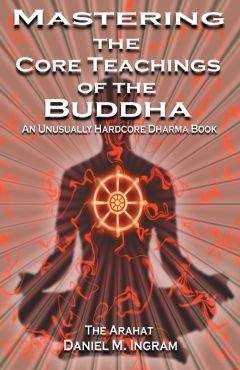Daniel Ingram - Mastering the Core Teachings of Buddha - An Unusually Hardcore Dharma Book
На электронном книжном портале my-library.info можно читать бесплатно книги онлайн без регистрации, в том числе Daniel Ingram - Mastering the Core Teachings of Buddha - An Unusually Hardcore Dharma Book. Жанр: Прочее издательство -, год 2004. В онлайн доступе вы получите полную версию книги с кратким содержанием для ознакомления, сможете читать аннотацию к книге (предисловие), увидеть рецензии тех, кто произведение уже прочитал и их экспертное мнение о прочитанном.
Кроме того, в библиотеке онлайн my-library.info вы найдете много новинок, которые заслуживают вашего внимания.

Daniel Ingram - Mastering the Core Teachings of Buddha - An Unusually Hardcore Dharma Book краткое содержание
Mastering the Core Teachings of Buddha - An Unusually Hardcore Dharma Book читать онлайн бесплатно
Buddhism also contains a strangely large number of True Self teachings, though if you told most Buddhists this they would give you a good scolding. Many of these have their origins in Hindu Vedanta and Hindu Tantra. All the talk of Buddha Nature, the Bodhisattva Vow, and that sort of thing are True Self teachings. True Self teachings point out that this “awareness” is “who we are,” but it isn’t a thing, so it is not self.
They also point out that we actually are all these phenomena, rather than all of these phenomena being seen as something observed and thus not self, which they are also as they are utterly transient and not awareness. This teaching can help students actually examine their reality just as it is and sort of “inhabit it” in a honest and realistic way, or it can cause them to cling to things as “self” if they misunderstand this teaching. I will try again...
156
No-self vs. True Self
You see, as all phenomena are observed, they cannot possibly be the observer. Thus, the observer, which is awareness and not any of the phenomena pretending to be it, cannot possibly be a phenomenon and thus is not localized and doesn’t exist. This is no-self. However, all of these phenomena are actually us from the point of view of non-duality and interconnectedness, as the illusion of duality is just an illusion.
When the illusion of duality permanently collapses in final awakening, all that is left is all of these phenomena, which is True Self, i.e. the lack of a separate self and thus just all of this as it is. Remember, however, that no phenomena abide for even an instant, and so are empty of permanent abiding and thus of stable existence.
This all brings me to one of my favorite words, “non-dual,” a word that means that both duality and unity fail to clearly describe ultimate reality. As “awareness” is in some way separate from and unaffected by phenomena, we can’t say that that unity is the true answer. Unitive experiences arise out of strong concentration and can easily fool people into thinking they are the final answer. They are not.
That said, it is because “awareness” is not a phenomena, thing or localized in any place that you can’t say that duality is true. A duality implies something on both sides, an observer and an observed.
However, there is no phenomenal observer, so duality does not hold up under careful investigation. Until we have a lot of fundamental insight, the sense that duality is true can be very compelling and can cause all sorts of trouble. We extrapolate false dualities from sensations until we are very highly enlightened.
Thus, the word “non-dual” is an inherently paradoxical term, one that confounds reason and even our current experience of reality. If we accept the working hypothesis that non-duality is true, then we will be able to continue to reject both unitive and dualistic experiences as the true answer and continue to work towards awakening. This is probably the most practical application of discussions of no-self and True Self.
No-self and True Self are really just two sides of the same coin.
There is a great little poem by one Kalu Rinpoche that goes something like:
We live in illusion
And the appearance of things.
157
No-self vs. True Self
There is a reality:
We are that reality.
When you understand this,
You will see that you are nothing.
And, being nothing,
You are everything.
That is all.
There are many fine poems on similar themes presented in Sogyal Rinpoche’s The Tibetan Book of Living and Dying. It is because we are none of this that freedom is possible. It is because we are all of this that compassionate action for all beings and ourselves is so important. To truly understand this moment is to truly understand both, which is the Middle Way between these two extremes (see Nisargadatta’s I Am That for a very down-to-earth discussion of these issues). While only insight practices will accomplish this, there are some concentration attainments (the last four jhanas or Formless Realms) that can really help put things in proper perspective, though they do not directly cause deep insights and awakening unless the true nature of the sensations that make them up is understood.
158
Mastering the Core Teachings of the Buddha
23.THE FORMLESS REALMS
The formless realms never fail to impress and amaze. They can also be taken to be much more significant than they really are. The trick is to come to a balanced understanding of what they are and what they aren’t, what they are useful for and what they do not accomplish. This is not always easy.
BOUNDLESS SPACE, THE FIFTH JHANA
To attain this state, one simply continues to cultivate the fourth jhana and begins to not pay attention to the objects in the meditation space but gently to space itself. How big is reality? Tuning into the panoramic quality of attention itself when in the fourth jhana can be very helpful. This is quite a fine line, but it can definitely be done.
Forms then slip away like ghosts into thin air, and the mind turns to boundless space, the fifth jhana, as the object of concentration.
This jhana is often called “Infinite Space”, as the next one is often called “Infinite Consciousness”, but I prefer the word “boundless”
because it is much closer to the actual experience of these stages. People imagine that they might simultaneously perceive the whole of space, but what actually happens is that the perceptual boundaries drop away and a very unitive openness prevails. This open quality itself becomes the primary focus rather than what is unified in that openness. This aspect was already present in the 4th Jhana, but now it comes to the fore. The same is true of the next formless realm.
This is not necessarily as perfectly clean as it sounds, depending on how solidly one in this state, but it still quite spectacular. When this state is really cultivated, all or most images and sense of a body are gone, and almost all that is left is vastness. There is still thought and the illusion of a separate self, i.e. duality, but the mind is extremely quiet and the duality subtle. The equanimity from the 4th Jhana remains, as the formless realms use this state as their foundation. Sounds might still be noticeable depending on the depth of the state. Note, if one attains this state while meditating with the eyes open it may have a very different quality to it than if the eyes are closed.
From this state, the meditator has a few options. They can get stuck, which may be more prone to happening if they are incorrectly practicing The Formless Realms
non-dual formless practices such as dzogchen by fixating too much on the phrase “space-like awareness.” They can also either go on to the next formless realm (boundless consciousness) or investigate this state and thus begin the progress of insight. If this last option is chosen, special care and extreme precision must be given to each and every instant that the many sensations that make up the perception of space, silence or equanimity are perceived so as to see each of these experiences arise and pass completely in each instant, not satisfy, and not be self.
It may seem odd to think of the sensations of space arising and passing away each instant, but space is a conditioned aspect of relative reality, and is thus impermanent like all other aspects of experiential reality. This can be an important attainment, as it clarifies that awareness, that non-thing that is often described as space-like, is actually not even space, though it is not separate from space, as in the chapter called No-self vs. True Self.
There are few things quite as odd, profound, and possibly
disconcerting as investigating the first three formless realms and perceiving them strobe in and out of existence, but this is powerful practice and a very valuable and high attainment. Again, this state may be left and insight practices begun with the benefits of the residue of this state calming, opening and stabilizing the mind for a short time after it ends.
BOUNDLESS CONSCIOUSNESS, THE SIXTH JHANA
If the meditator wishes to go further into the formless realms, then they should continue to cultivate attention to boundless space and begin to notice that they are conscious of all of it, and thus space is filled with consciousness. As some point the mind will abandon boundless space and shift to perceiving boundless consciousness, the sixth jhana. This can feel outrageously unitive, as consciousness seems to fill the whole universe. Space becomes “luminous,” and this can be confused with descriptions of the fundamental luminosity of awareness and with non-duality, though this is definitely not the attainment of the understanding of those. Again, equanimity prevails. This state has a sense of presence to it that boundless space doesn't. It is also a great staging ground for exploration of the “psychic powers.”
160
The Formless Realms
From here the meditator has various options. They can get stuck, which can happen fairly easily if they are mistaking dzogchen or other non-dual formless practices for meditation on the concentration object of boundless consciousness, again due to misunderstanding or overemphasizing the phrase “space-like awareness.” They can also go on to cultivate the next formless realm (nothingness), or they can investigate boundless consciousness and then begin the progress of insight.
For this last option, extremely careful attention must be given to each moment that the sensations that make up the perceptions of consciousness, vastness, or equanimity arise and pass away. Great precision must be given to the fact that these sensations do not satisfy and cannot be self or imply a separate self. Because of how
fundamentally disconcerting (unsatisfactory) it can be to have the three illusions shattered at this level of clarity and simplicity, this is not an easy practice but can be very powerful. It is actually much more likely that such insights into the true nature of the three first formless realms will arise spontaneously due to previous skillful insight practices.
Again, experiencing boundless consciousness strobing in and out of reality can be profoundly helpful in convincing us that even boundless consciousness that fills the vastness of space is not awareness, though awareness cannot be said to be separate from consciousness. What is observing boundless consciousness strobe in and out of reality? Now, there is a question, perhaps The Question.
NOTHINGNESS, THE SEVENTH JHANA
If the meditator wishes to attain to the next formless realm, that of nothingness, they simply cultivate the jhana of boundless consciousness and disenchant themselves with the vastness and luminosity of that state.
Eventually, the mind will abandon these and shift to the jhana of nothingness. To imagine this state, imagine space with all of the lights completely out, so that there is no vastness, and almost no sensations other than those of nothingness. It is almost as though attention is out of phase with nearly all phenomena except those that imply nothingness.
They are still there somewhere, but they are not being attended to.
This jhana is different from the previous two formless realms in that they are quite present to reality in some way and panoramic in 161
The Formless Realms
perspective, whereas nothingness is more turned away from phenomena and perhaps more focused in some way. There is, however, some very subtle thought and some extremely subtle sense of a separate self. Note well, nothingness is absolutely not emptiness, though it is empty, but this is not the attainment of this understanding. However, one can easily be convinced that this is emptiness due to the extreme profundity of it.
As before, this jhana can have different degrees of intensity to it.
Even when one is not strongly in it, there is a sense of being out of phase with reality, like being dissociated. Reality is there, but you have tuned it out on your radio. Note well, this is very different from just being “tuned out” in the colloquial sense.
While equanimity prevails, this state can be a bit scary at first, and this can cause some instability of this state. Now even consciousness and space are basically gone. However, there is still awareness of this state, indicating that there can be awareness that is not particularly consciousness or space. This really helps debunk the sense that awareness is consciousness or space or even a thing, that we are our body, etc. That said, it is not nothingness either. Nothingness may be perceived, whereas awareness may not.
From this state, the mind may get stuck, but this is not quite as likely as with the first two formless states, as this state is quite refined but not as breathtaking as the first two in some ways. The meditator may then try to move on to the next jhana, or may investigate this state. It may seem incredible that the sensations of nothingness itself could be observed to arise and pass, i.e. strobe in and out of reality, or that they could be known to not satisfy or not be self. However, this is definitely possible, if potentially quite disconcerting due to its extreme profundity and ability to really kick some sense into the mind about the truth of things. It also helps debunk the false idea that “The Void” or
“awareness” is nothingness. It is not even this. Remember, no sensation can observe another, so anything you can think of cannot be said to be
“awareness.”
By simply paying close attention to every instant that nothingness or equanimity is perceived, and with precise attention to the exact arising and passing of each of these, that these transient moments do not satisfy, and that these neither can impute nor can be a separate self, the three 162
The Formless Realms
illusions can begin to be penetrated in the highest state in which this can be accomplished. As this is a particularly subtle business, the meditator may also leave the jhana and begin insight practice in the afterglow of this state as before. Strobing sensations of nothingness are more likely to arise during the progress of insight in the stage called High Equanimity for those with very strong concentration skills.
NEITHER PERCEPTION NOR YET NON-PERCEPTION,
THE EIGHTH JHANA
If the meditator wishes to attain the next jhana, they simply hang out in nothingness until they get bored with perception entirely and understand that even perception is somehow disconcerting. Thus, the mind will eventually shift on its own to the state with the perplexing but thoroughly appropriate title of “neither perception nor yet non-perception,” hereafter “the eighth jhana” for the sake of brevity.
This state is largely incomprehensible, but it is absolutely not emptiness. It is empty, but this is not the attainment of that understanding. The eighth jhana may very easily be confused as being emptiness, especially if it is attained through insight practices (remember that insight practices can simultaneously cultivate concentration and wisdom). There is no reasonable way to attempt to describe this state, save for that it is a mind state, and thus is not emptiness, as emptiness is not a mind state or anything else for that matter. I am tempted to say that one is simultaneously focused so narrowly that one notices nothing and yet so broadly that one doesn’t notice even that, but such a description doesn’t quite do this state justice. One way or the other, there is complete inattention to diversity. The eighth jhana is the highest of the states of concentration that can be attained, ignoring the attainment of the cessation of perception and feeling, see the Appendix.
Похожие книги на "Mastering the Core Teachings of Buddha - An Unusually Hardcore Dharma Book", Daniel Ingram
Daniel Ingram читать все книги автора по порядку
Daniel Ingram - все книги автора в одном месте читать по порядку полные версии на сайте онлайн библиотеки My-Library.Info.




